Menu
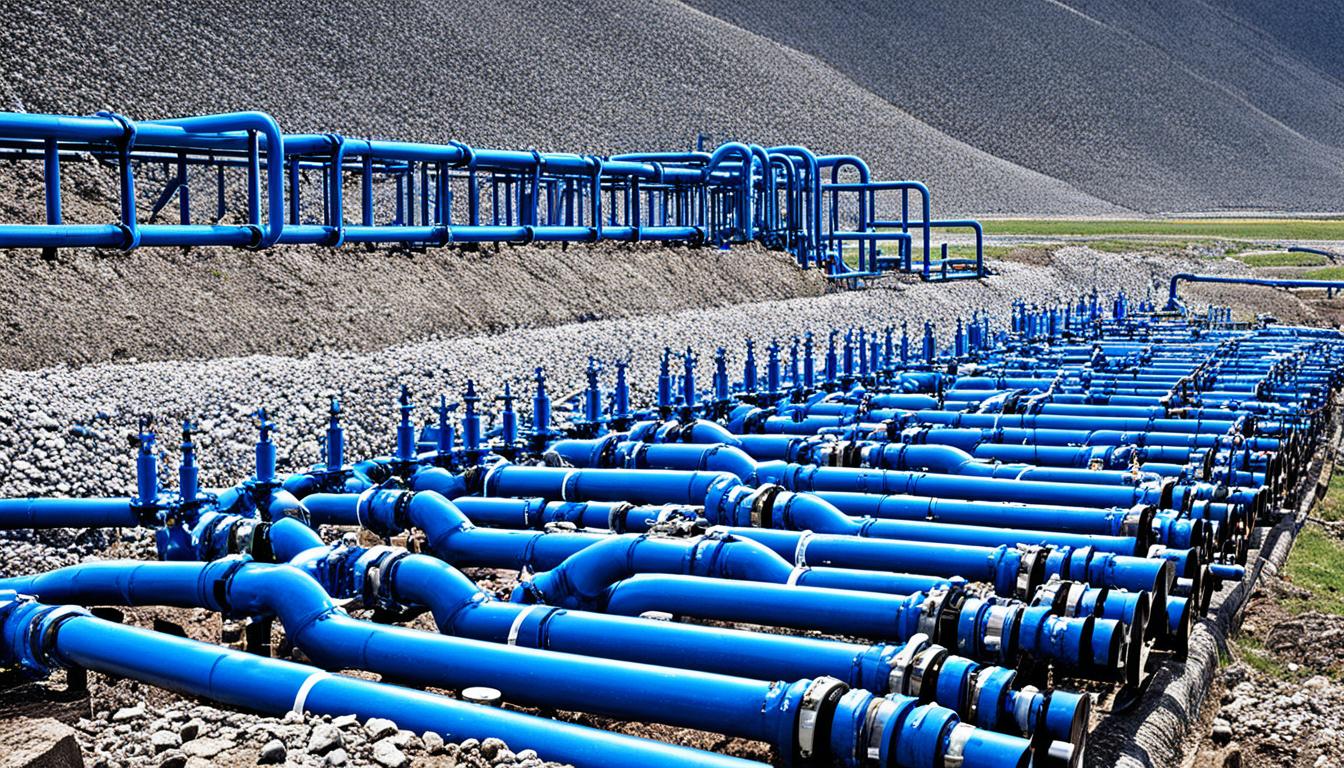
Barcelona managed to cut its water use by 25% thanks to a clever water system. This success shows us how smart water methods can save our water and keep its use stable. This city used repairs, real-time checks, and smart data to lead the way in better global water management.
My goal is to talk about new, better ways to manage water. It’s key to make sure water is used wisely and to support the right water plans. We need to talk about how to use our water well now without harming the future.
For a more detailed look at improving how we manage water, check out this article on smart water solutions and success in Barcelona.
Water resource management is key to protecting people and nature. As the need for water grows because of more people and climate change, we must use water smarter than before.
Making sure our drinking water is pure is a big challenge. The United Nations warns that by 2030, we could be 40% short of the water we need. Each person uses around 101.5 gallons every day. This shows we have to use water more wisely.
Distributing non-drinking water for industries and farming is also a big issue. About 70% of the world’s water and over 40% in OECD countries goes to farming. Dirty water causes diseases like cholera and typhoid.
Looking ahead, we will need to manage water in more sustainable ways. With more people and changing climates, we must handle water better. This can also help fight climate change by saving water and cutting down on pollution.
So, we aim for water security. This means using water to help but also being aware it can harm. The Water Security and Integrated Water Resources Management Global Solutions Group (GSG) is working on this, offering advice and practical help.
Goal 6.5 about water is essential, but other goals also depend on managing water well. So, good water practices are not just one aim but a foundation for achieving many development goals.
Fit-for-purpose water is key in saving water wisely. It helps us use water where it’s needed, at the right quality. This is important for keeping our water sources safe and plentiful.
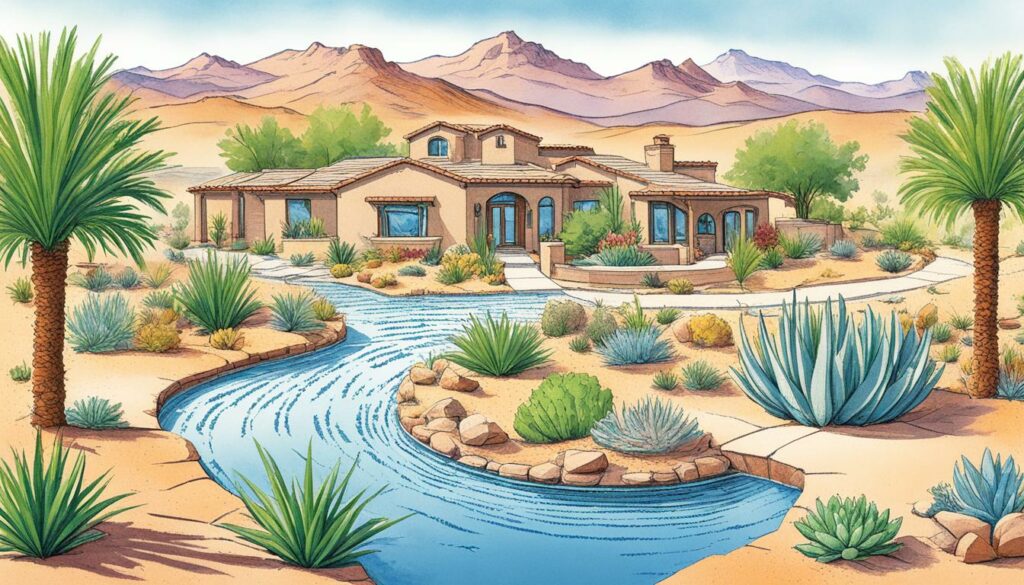
Drinking water has to be very safe, free from harmful chemicals and germs. We’re finding new ways to make water safe to drink from rainwater and used water. Starting in July 2014, Project C1.3 is looking into this, filling gaps in knowing how to keep our city’s water safe. It also focuses on using rainwater and waste water more.
Non-drinking water is used for farming or making things, not for drinking. It can come from treating used water or from rain. Using this water more means less strain on our main water sources. The project aims to test new ways of making this water safe, even in tough situations.
Water we have fun in, like at pools, needs careful watching. It must be clean and safe. We’re looking into new materials and methods to clean this water. These new ways focus on removing harmful stuff in the water, making fun places safer.
Factories and other big places need water of a certain quality for their machines and products. This project works on getting the right water to these places. It looks at ways to make and check the best water for these needs. This makes sure water is used well and safely in industry.
| Water Category | Source | Application | Key Considerations |
|---|---|---|---|
| Potable Water | Stormwater, Greywater | Human Consumption | Safety, Purity |
| Non-Potable Water | Treated Wastewater, Stormwater | Agriculture, Industry | Quality Requirements |
| Recreational Water | Recycled Water, Treated Water | Swimming Pools, Water Parks | Disinfection, pH Balance |
| Process Water | Industrial Wastewater, Recycled Water | Industrial Applications | Specific Quality Needs |
Innovative methods are changing how we manage water. For example, in California, they are increasing water storage by 500,000 acre-feet. This is part of a big plan to deal with climate change and changing weather. Since 2016, the State Water Board has given 20 permits for such projects.
The Merced Project in California is a good example. It received a permit to put up to 10,000 acre-feet of water back into the ground. They use different ways like basins, wells, and special wells for this. These steps help to not waste floodwater and to keep water available for the long term.
Reusing greywater is also a great way to save water. Water from sinks, showers, and washing machines can be used for things like watering plants. This lowers the need for new water. Desalination, which makes sea water usable, is becoming cheaper because of new tech. It’s now a good option for places that don’t have much fresh water.
Rainwater can be collected for use in gardening and flushing toilets. This saves water from the city and helps keep underground water safe. Water can also be cleaned and reused, helping to save fresh water and adding nutrients back to the soil.
Using smart technology makes all these methods even better. Devices talking via the Internet and data help to save water, find leaks, and work more efficiently. It all leads to saving money and better care of water.
In the end, smart irrigation, using water only where and when it’s needed, and good water management practices are vital. They look at water needs from an economic, social, and natural point of view. This is key for keeping our water safe and enough for the future.
Today, more than 40% of the world faces water scarcity. Thus, using smart water techniques is key. These methods use IoT and data analysis to make water use smarter. They cut down on waste and make things more sustainable.
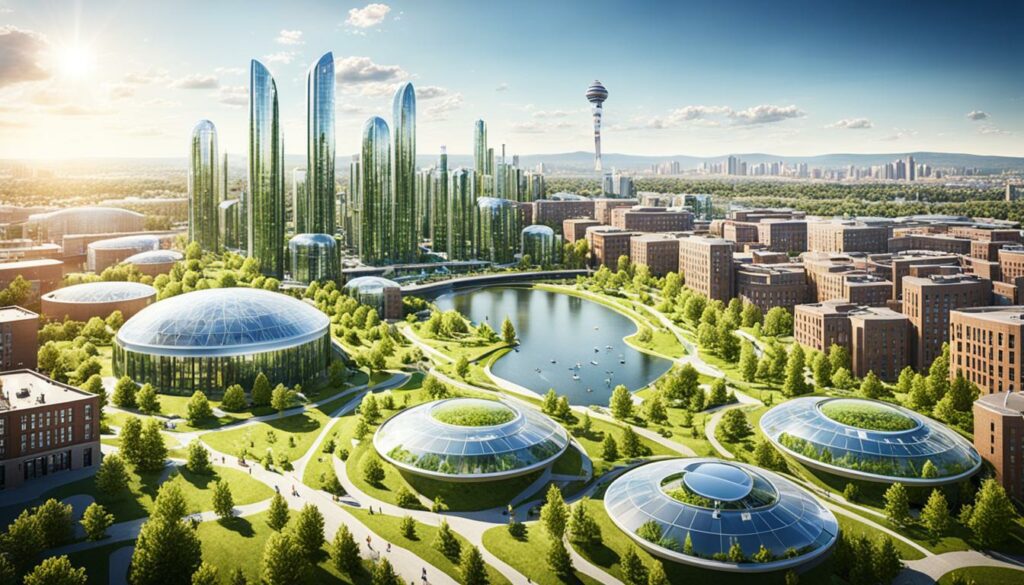
IoT changes how we watch over water. It puts sensors in the system to find leaks and oddities quickly. This saves water and money for everyone involved.
Data crunching and learning are huge in smart water tech. They look at tonnes of info to guess when water is needed most. For instance, they tell us when a drought might happen. This data helps us save water more wisely.
Also, smart water tech works great with other tools. Smart watering knows exactly how much water crops need. And reusing water from air units is another win for the environment.
Effective water management systems are crucial for protecting against 70% of natural disaster fatalities related to water incidents.
| Smart Water Management Benefits | Details |
|---|---|
| Financial Savings | Significant reductions in water bills for consumers and operational costs for utilities. |
| Water Conservation | Real-time leak detection and optimisation of water usage through IoT. |
| Operational Efficiency | Automated systems for better management of distribution networks. |
Barcelona’s use of smart water systems is a great model for improving water systems. It uses a big fibre optic network that connects nearly all homes. This network allows the city to use IoT systems, which makes managing the city easier.
The city installed 20,000 smart meters. These meters helped save 25% more water and $555,000 each year. It shows that using smart systems can save a lot of water and money.
The Sentilo platform helps a lot by putting in 18,000 sensors. These sensors check important things like the weather, how much electricity is used, water levels, air quality, and noise. Barcelona is now a leader in eco-friendly city growth. It gets key information on how to use and improve its water systems.
Barcelona’s smart water work is not just saving water. It’s also cutting costs and making new jobs. The city tests small projects which help it learn and grow. This makes it a major place for new urban ideas to be tried.
The water company in Barcelona, Aigües de Barcelona, is a key part of this. They started using smart water methods in 2013. Now they help 23 city councils. Their work shows how using data can be a smart way to plan and make decisions.
Barcelona’s smart irrigation is doing a big part to save water. It changes how much water is given based on the weather and what the plants need. They also use soil moisture sensors and a system that lets them control irrigation from far away. This helps those working in parks and gardens a lot, making their jobs easier.
| Statistics | Impact |
|---|---|
| 20,000 Smart Meters | 25% increase in water conservation, saving $555,000 annually |
| 18,000 Sensors on Sentilo Platform | Enhanced monitoring of weather, electricity, water, and air quality |
| Smart Irrigation System | Optimised daily tasks and reduced water consumption |
Barcelona’s smart water systems show how modern technology can really help. They have become a model for other cities facing water challenges. The city proves that advanced tech is key for better urban water systems.
Managing our limited water is key. By using maths and new methods, we make sure water goes where it’s needed. This helps everyone get a fair share and makes water use better.
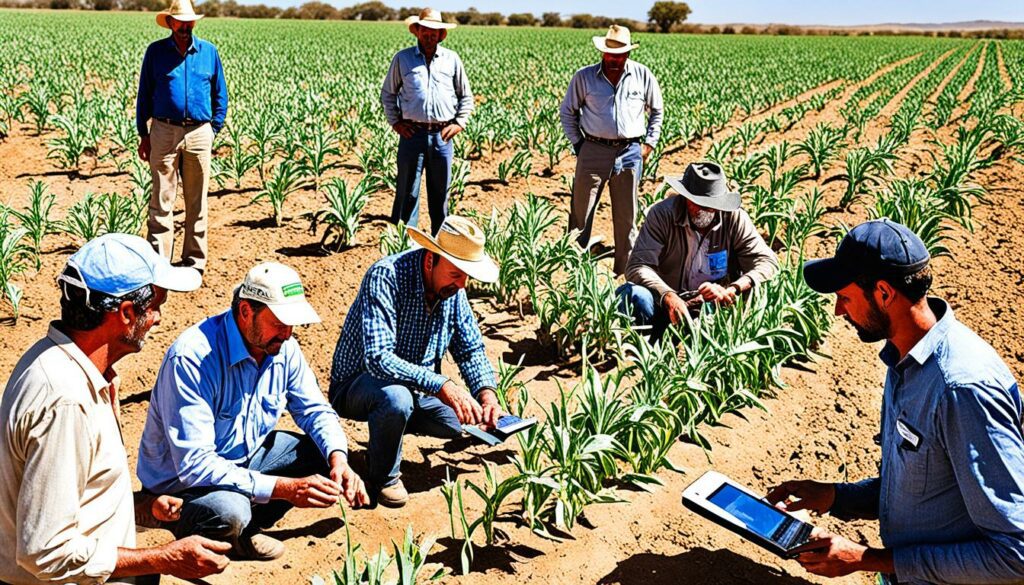
Linear programming helps a lot in managing water. It uses maths to figure out the best way to share water. This means water can be shared fairly for farming, industry, and homes. A good example is the Han River basin in China. There, big water projects have been tackled smartly. These include the South-North water transfer. This transfer helps decision-makers see which actions are best for the economy and fair sharing. They use a smart method called the Pareto front. This method helps sort out the best choices using math and algorithms.
Dynamic models help us use reservoirs better. In China’s Han River, these models are really important. They consider when it rains most, from May to October. By planning the release of water carefully, needs are met without causing floods. Plus, it’s good for making hydroelectric power. In places like Handan, these strategies have worked well, even under dry conditions.
Using these high-tech models is vital as more people need water. It makes sure water is used well, which is good for the economy and nature. By combining different methods, we keep improving how we handle water. This is great for both making sure there’s enough water and protecting the environment.
Water reuse and recycling are crucial in fighting water scarcity. An example is the California Municipal Wastewater Recycling Survey from 2009. It showed over 723,845 acre feet of recycled water used. About 29% goes to agriculture, 18% for landscaping, and 5% recharges groundwater.
There is little, less than 1%, that goes to making water safe for drinking. This shows how diverse water reuse is and its importance in managing water sustainably.
The Montebello Forebay Ground Water Recharge Project in California has succeeded for over 35 years. It highlights how recharging groundwater is a smart water reuse technique. In places like the Irvine Ranch Water District, recycled water use in tall buildings is affordable. It’s only about 9% more expensive than regular plumbing when the building is taller than seven stories. This example shows that using recycled water makes sense, both economically and for the planet.
| Location | Water Reuse Application |
|---|---|
| Koele Golf Course, Lanai, Hawaii | Irrigation |
| Palo Verde Nuclear Generating Station, Arizona | Cooling Applications |
| City of Santa Rosa, California | Irrigation of Vineyards |
Water reuse isn’t just for towns and cities. It’s also key in industries. For example, the Palo Verde Nuclear Generating Station in Arizona uses it for cooling. And projects like recycling at Mono Lake in California help keep water quality high. They also save water for local ecosystems, showing how important recycling water is for nature.
These approaches are vital in facing water shortages. They also highlight the importance of recycling water today. Groups like the WaterReuse Association are key. They help spread the word and push for using water smarter around the world.
Using advanced water treatment methods is key to having high-quality water in all sectors. We strive to achieve tough standards and improve efficiency in many areas through these methods.
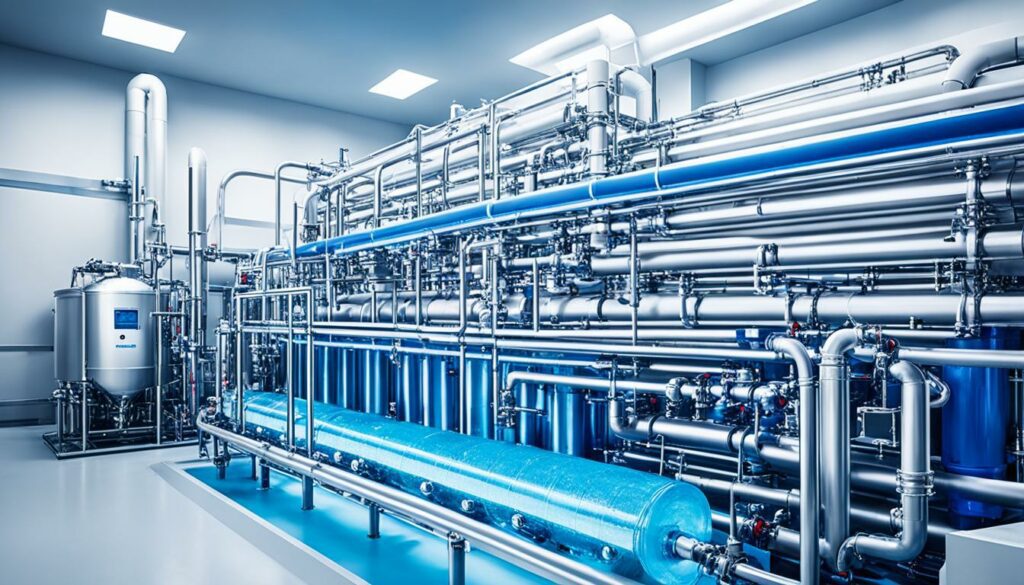
Filtration is essential in water management to rid water of harmful substances. This ensures water for agriculture, livestock, and more is pure. Membrane bioreactors and nanomembranes are new technologies that work well.
These methods can remove bacteria and particles. They make sure our water is safe to use.
Deionization is crucial for making water pure. It takes out ions and particles, making water ready for industries like electronics. This ensures that industrial machines work well and last longer.
This process is very beneficial for certain industries. It helps prevent damage and keeps operations smooth.
By using advanced methods like filtration and deionization, our water businesses become more sustainable. Companies such as Amiad AGWATER lead in offering these solutions. They make our environment healthier while boosting productivity for everyone.
Water scarcity affects 2.3 billion people worldwide today. We need to use water management strategies to address this issue. Even though there’s a lot of water on earth, not everyone can easily get to it.
More people and cities need more water. This puts a lot of pressure on the water we have. Farming uses up most of the water. So, we must manage water well to meet everyone’s needs.
New technologies are helping a lot. For example, in Kenya, they’ve built 130 sand dams to save water for dry times. These smart systems let us use water better by watching and adjusting water use in real time.
“By 2050, over 140 million people could be displaced within their countries due to climate-related water issues.”
It’s vital that everyone works together to save water. In Chile, 25% of their water problems come from the way people have changed the climate. So, making the right policies is crucial.
Now, let’s look at how water scarcity affects different parts of the world.
| Region | Challenge | Strategy |
|---|---|---|
| Niger | 50% population lacks access to drinking water | Investment in water infrastructure |
| South Africa | Under-prepared infrastructure | Upgrading water distribution networks |
| Europe | Droughts drying up rivers | Improved water conservation and management |
Every year, about 829,000 people die from diseases linked to dirty water and poor sanitation. So, saving water isn’t just about the environment. It’s also about keeping people healthy and treating everyone fairly.
As we get better at reusing and sharing water, we can prepare for the future better. This will help us deal with the coming challenges of not having enough water.
Getting everyone involved in water management is key to success. Research shows we need more studies to understand how talking to people affects water management. We must do more to see the real impact of engaging with stakeholders.
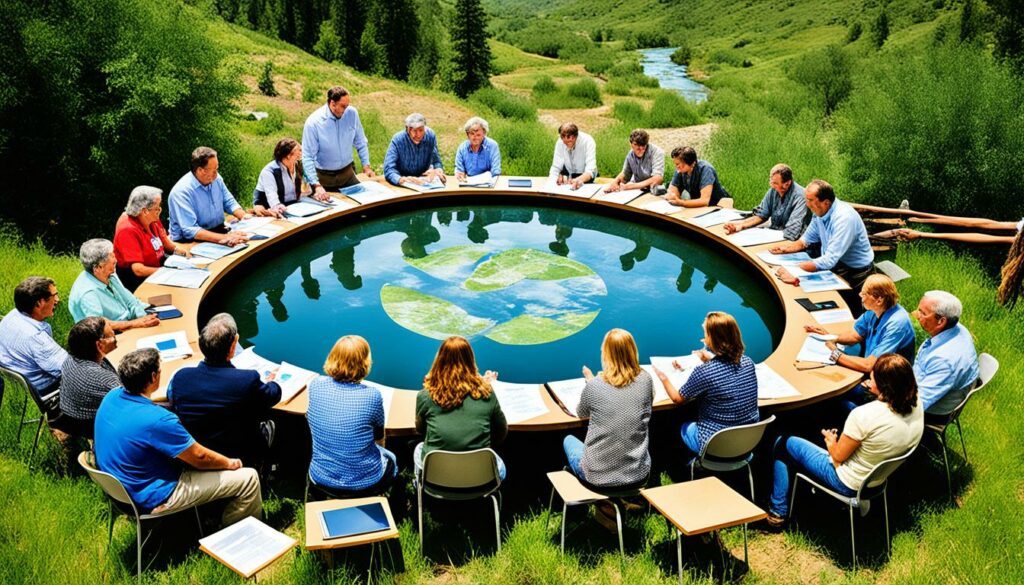
Using the same words and theories helps us work together better. By following known methods, we can study engagement more openly and clearly. Working together improves the way we use water and helps the environment and people too.
Farmers working with water companies use smart irrigation to save water and grow crops well. And, companies joining with green groups make cleaner processes. This helps cut down pollution and use resources wisely.
Energy companies and communities working together means less harm to water and happier communities. By recycling water and saving on it, they help the environment and reduce pollution. These actions also protect our water animals.
Collaborating has many benefits:
Many studies prove that working together works well. For example, research by Leach shows that groups following democratic rules succeed. Other studies talk about both the good and hard parts of working together.
More experts agree that talking a lot and thinking in complex ways is good for water management. They say good talk and planning makes teams working on water issues better, covering all needs.
By really teaming up, we can make better progress in handling water issues. I strongly support working together to manage our water wisely.
Optimised water management is key for both saving the planet and boosting economies. By wisely planning and using water for things like drinks, sanitation, making food, producing energy, and moving goods by water, we help the environment and support goals like the SDGs.
The World Bank backs work to make sure countries are secure with their water. Full countries need water security to deal with growing cities and changes in our climate. By using water well and avoiding its bad effects, we build a better future for all.
We focus on keeping our water sources safe, fighting climate change, and joining up how we use water to meet the SDGs. This joined-up way means we make the best use of water, help economies grow, and cut down on poverty.
The value of managing water right really shows in places like the Weihe River Basin. This area boosts its water supplies by building reservoirs and moving water around. This way, places like Dongzhuang, Doumen, and Tingkou see better water use, helping their economies grow.
“The Yellow River Basin, vital to China’s socio-economic development and ecological security, exemplifies the transformative power of effective water resource management.”
Studies that use models help us see how things like growing populations and money-making activities impact water. We need info from stats, water reports, and more to make these studies right.
Better water management also fights climate change. We can make plans using data on people, what they do, how they live, and using land and food. By recycling water and caring for the environment, we better our world and our economies.
| Region | Economic Contribution | Water Management Strategies |
|---|---|---|
| Guanzhong Area | 70% of Shaanxi Province’s total economic volume | Reservoir construction, water transfer projects |
| Yellow River Basin | Significant impact on China’s socio-economic development | Ecological protection, high-quality development |
In the end, good water management is more than saving money. It helps make water more available, cuts waste, and lessens harm to our planet and its life. This shows its key role in making development sustainable.
Keeping our waters clean and plentiful is key for everyone’s well-being. But several problems make it hard to save water. It’s crucial to understand these issues to move towards using water sustainably.
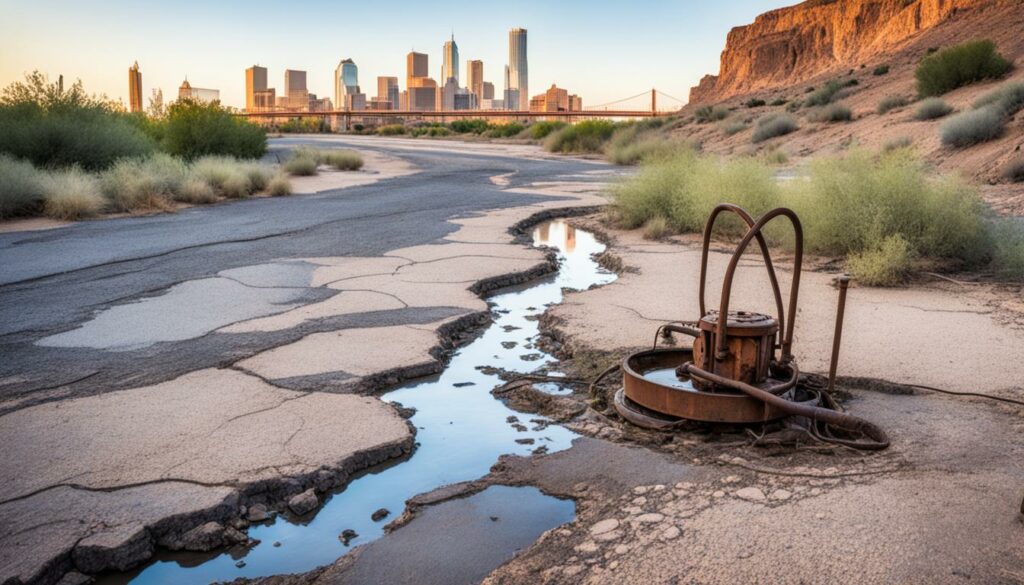
Following rules can often be tough. On one side, we must have rules to keep water safe and share it fairly. But, some rules might not let us try new and smart ways to save water, like making seawater drinkable or getting water from the air.
Not having enough money is a big issue too. Building things to manage water needs a lot of cash. This is even harder in places that are still developing. Though we want to use water well without hurting nature, the costs to start can stop efforts.
Getting everyone to agree on saving water is also difficult. It means changing our daily habits, which many don’t like. To help people get on board, teaching them and raising awareness are crucial steps.
Deciding how to manage water can also lead to its own set of challenges. Some think it’s best to plan everything from the top down. Others prefer letting people in the community have a say. Finding the right mix is important for good water use plans.
| Challenge | Description |
|---|---|
| Regulatory Compliance | Stringent regulations may impede innovative conservation solutions. |
| Funding Constraints | Significant investments are needed for infrastructure, which can be a barrier. |
| Public Acceptance | Behavioural change is required, often resisted by communities. |
| Human Activity | Urbanisation and industrial processes increase pollution and water scarcity. |
| Planning Approaches | Balancing top-down and bottom-up methodologies is challenging. |
Overcoming these water-saving hurdles is a team effort. It requires help from governments, businesses, and people like you. With new ideas, enough money, and a push for learning and sharing, we can all make a real difference in how we use water.
Learning about water conservation is key to wisely using our water. By teaching people, we form a group that values saving water. The Alliance for Water Efficiency (AWE) is a leader in teaching about water savings. They run a lot of programmes and use many resources to spread the message.
At AWE, anyone can learn, from beginners to experts. They offer online courses, in-person events, and chances to connect with others. All these activities help people understand the best ways to save water. They work with many groups, like local authorities and businesses, to reach more people.
Need information on saving water? AWE’s Resource Library has it all. They also have a cool tool, the Water Use Calculator for homes. It helps you see where you can cut back, making water saving at home easier.
AWE’s website also has tips for sharing the message of water’s worth. It’s great for local governments and water companies wanting to encourage smart water use. AWE’s Never Waste campaign focuses on stopping water waste, getting more people involved in saving water.
In Alabama, a lot of waterways need protection for our water. Local groups are working hard on this. They teach folks how to look after their part of the water supply. Together, they use techniques to stop pollution and save water, teaching and doing at the same time.
It takes everyone, even farmers, to protect our water. Groups like the Alabama Agribusiness Council and the Alabama Cattlemen’s Association help them learn how. They push methods that keep water clean. This work fights the biggest water problem in the U.S.: stormwater pollution.
By learning and making every drop count, we save water for those coming after us. Supporting water education is important. It makes us all part of a group that cares about water. This way, we build a future where water is well looked after.
Optimising how we manage water isn’t just wise; it’s crucial for our future. We face using 40% less water globally by 2030. So, we must get smarter about our water use. Each day, a person uses a lot of water, about 101.5 gallons. This puts a big strain on the water we have available.
A lot of the water we use goes to farming. In fact, 70% of all water use is for growing crops. By changing how they use water, farmers can help themselves and the planet. They can make more money, help reduce poverty, and protect the environment by using methods like drip irrigation and collecting rainwater. These methods save water, stop soil from washing away, and grow more food.
Using water well can also fight climate change. We need to save water and find ways to cut down on the pollution water use causes. This will help us deal with the strange weather patterns and changes in how often it rains. To do this, we need to use old ways like saving rainwater, but also new ways like turning sea water into drinkable water.
To wrap up, we must manage our water wisely for people, the economy, and the planet. Everyone, from leaders to farmers to you, can help. As more of us and the climate change, we need to be clever and caring with our water. This shows how much we can look after the Earth when we work together.
Water resource management uses ways to handle water sources well. It aims to meet the needs of people, farms, and factories without wasting. This helps sustain water supplies for everyone.
Using water efficiently is key to saving it. This reduces waste and helps water keep up with more people and a changing climate.
Ensuring clean and safe drinking water is a big challenge. So is deciding how to share water between industry and farms. These challenges are made worse by more people and a changing climate.
In the future, we’ll need better ways to manage water. This is because more people and climate change will put more pressure on water supplies.
Fit-for-purpose water matches water quality to its use. Water can be for drinking, industry, play, or processes. Each type needs different treatment to be safe and usable.
Smart water management uses high-tech tools like sensors and data analysis. It helps us make the most of water by finding leaks and monitoring use in real-time. This leads to saving water and money.
In Barcelona, IoT and data analysis cut water use by 25%. This made the water systems better. Now, other places use this as a good example in fighting water scarcity.
Methods like linear programming help share water fairly. Dynamic programming makes managing water in dams better, reducing flood risks and meeting water needs.
Reusing water fights water scarcity. Treated wastewater can be used for farming, factories, and more. This saves fresh water and keeps the environment healthy through recycling.
For various needs, advanced water treatments are vital. They clean water for different sectors, like industry. This means water is safe and good for use.
Big steps like new tech, teamwork, and good policies help fight water scarcity. Smart ways to manage water and reusing it can solve a lot of these problems.
Involving everyone in water planning is key. This includes water officials, governments, and the local community. It makes sure everyone’s needs are considered for a lasting, good plan.
Better water use helps nature and money. It makes more water available, cuts down on waste, and protects the environment and wildlife. This is good for both the Earth and our wallets.
Facing the law, finding money for new projects, and getting people on board are tough. Overcoming these issues is vital for success in water management.
Teaching and spreading the word helps people understand water issues. It builds a culture of looking after water and using it wisely, both for people and businesses.